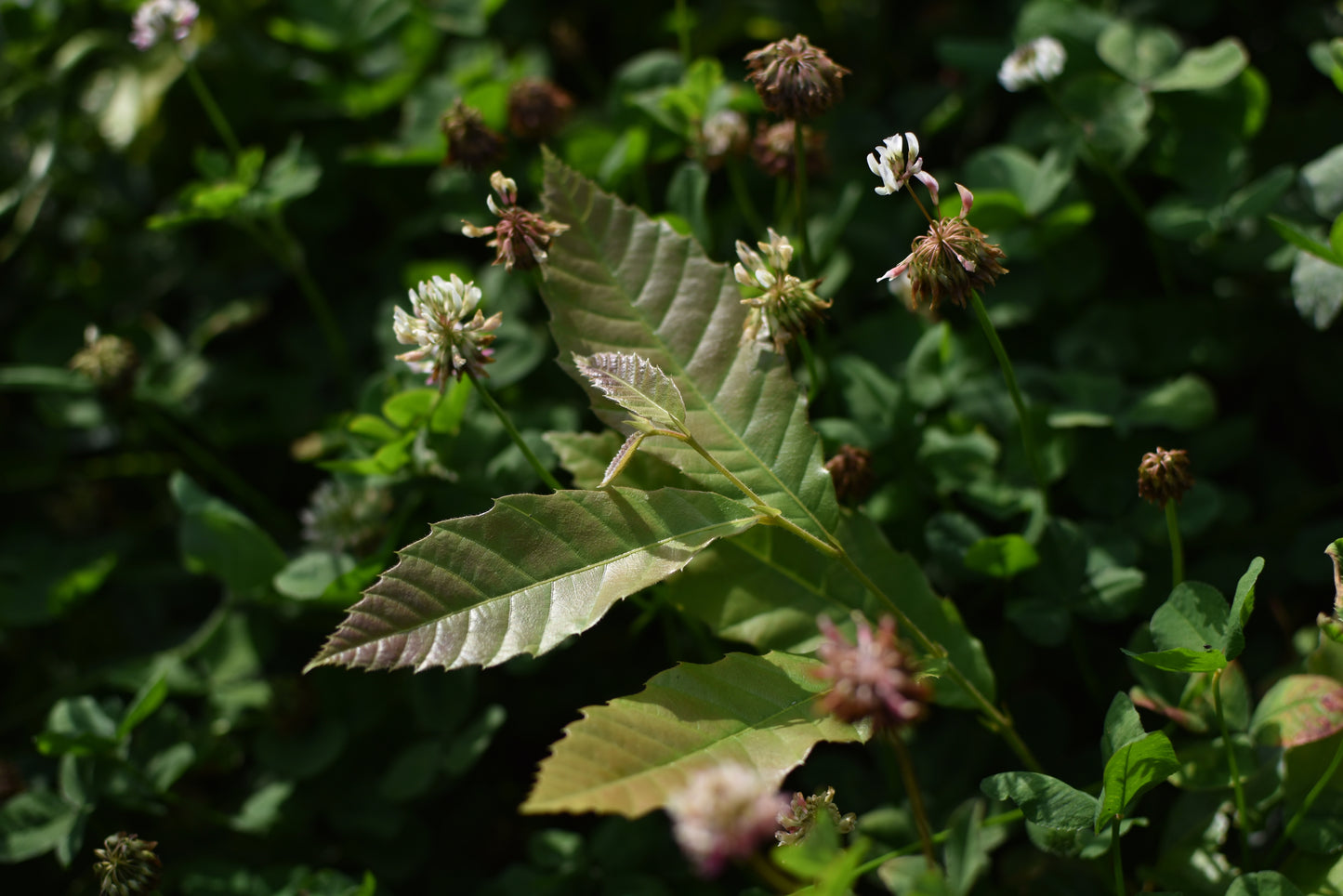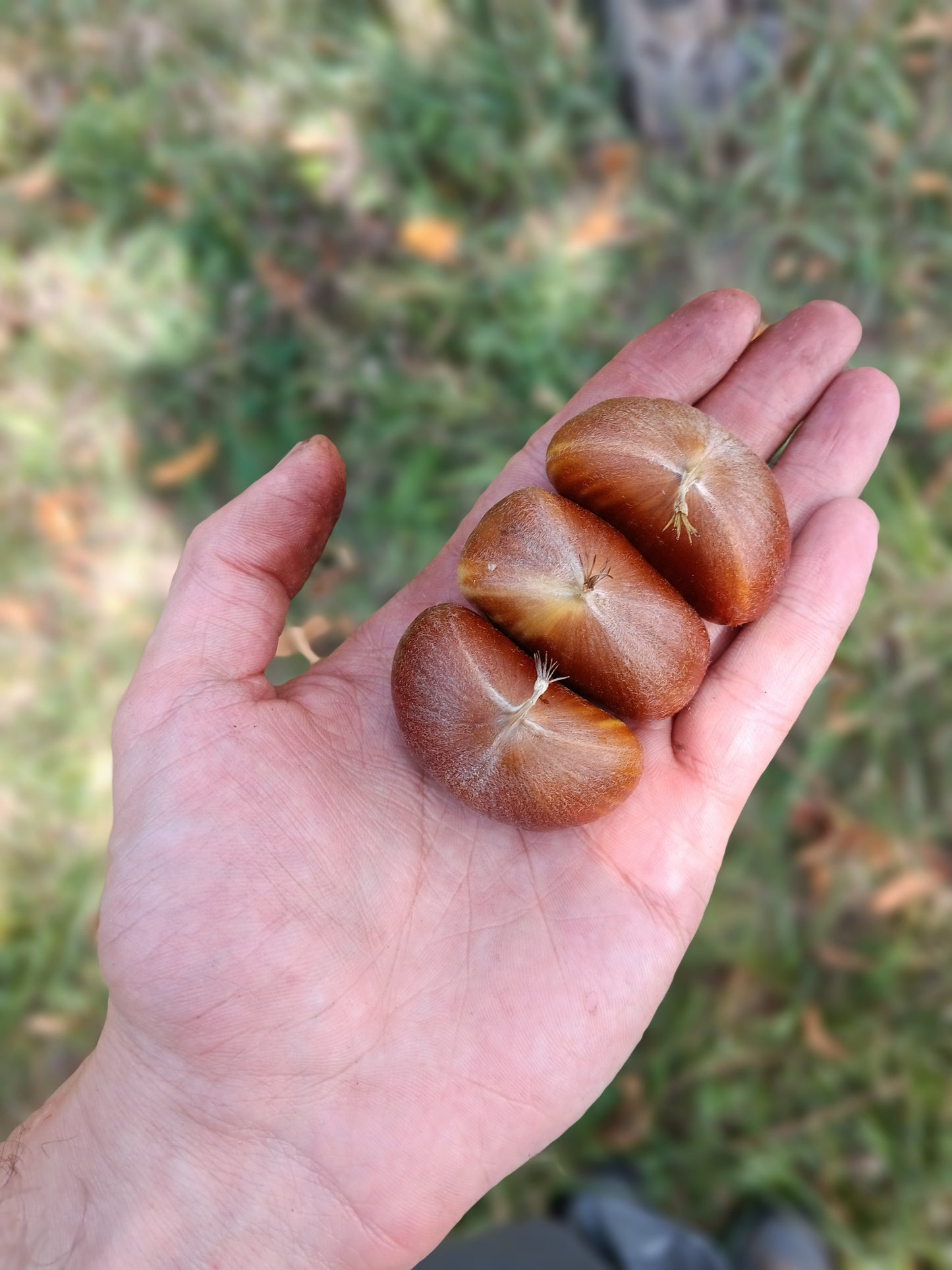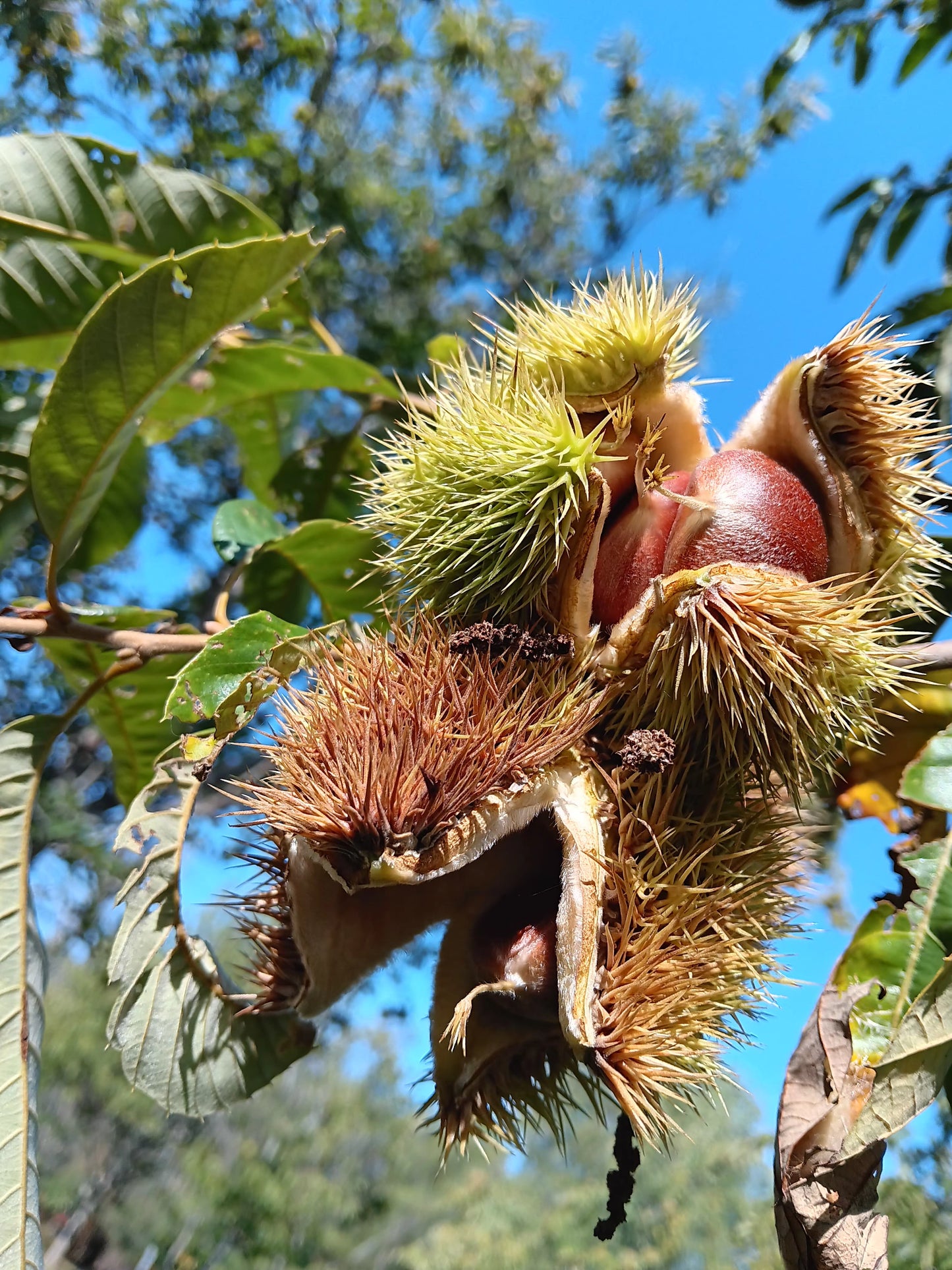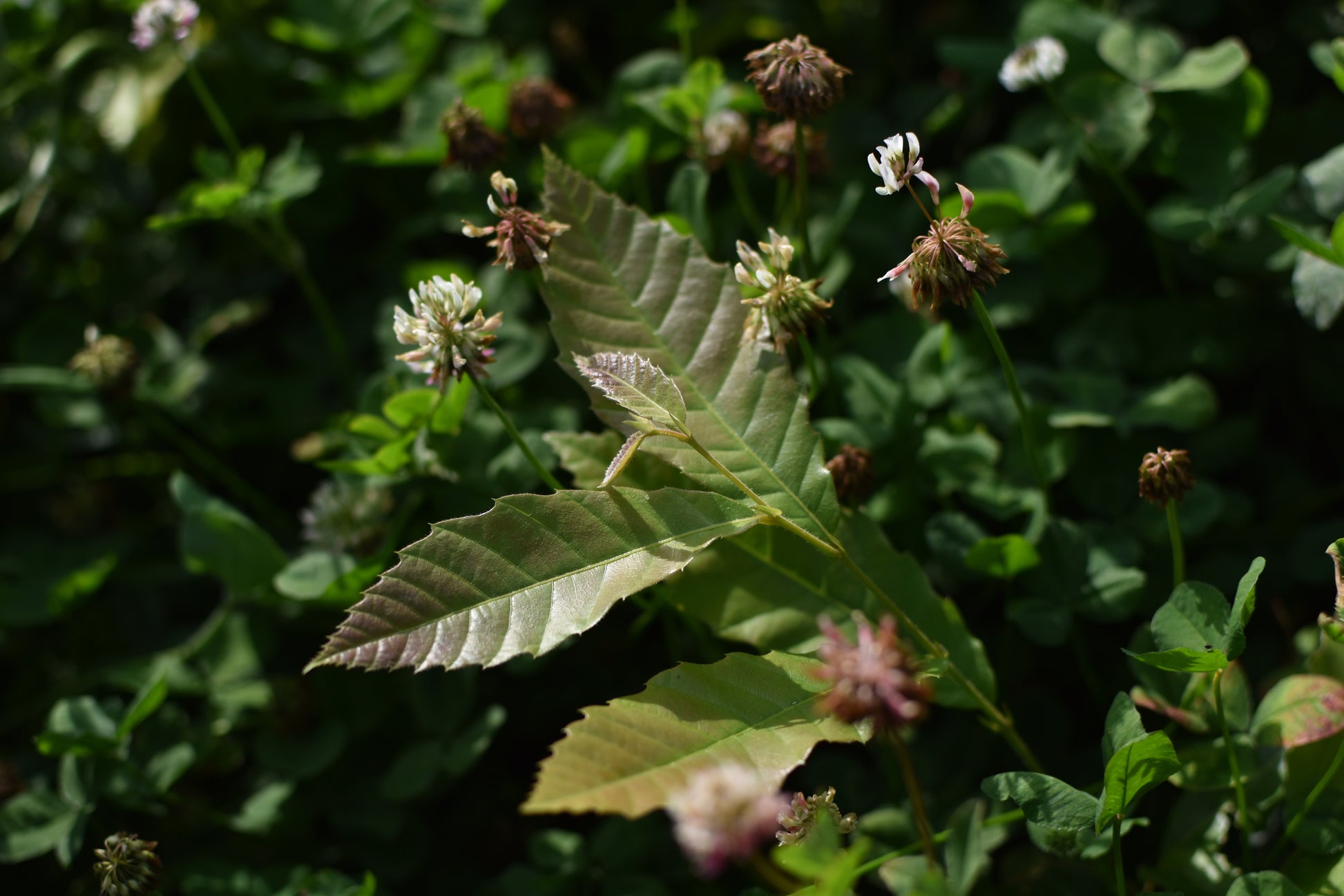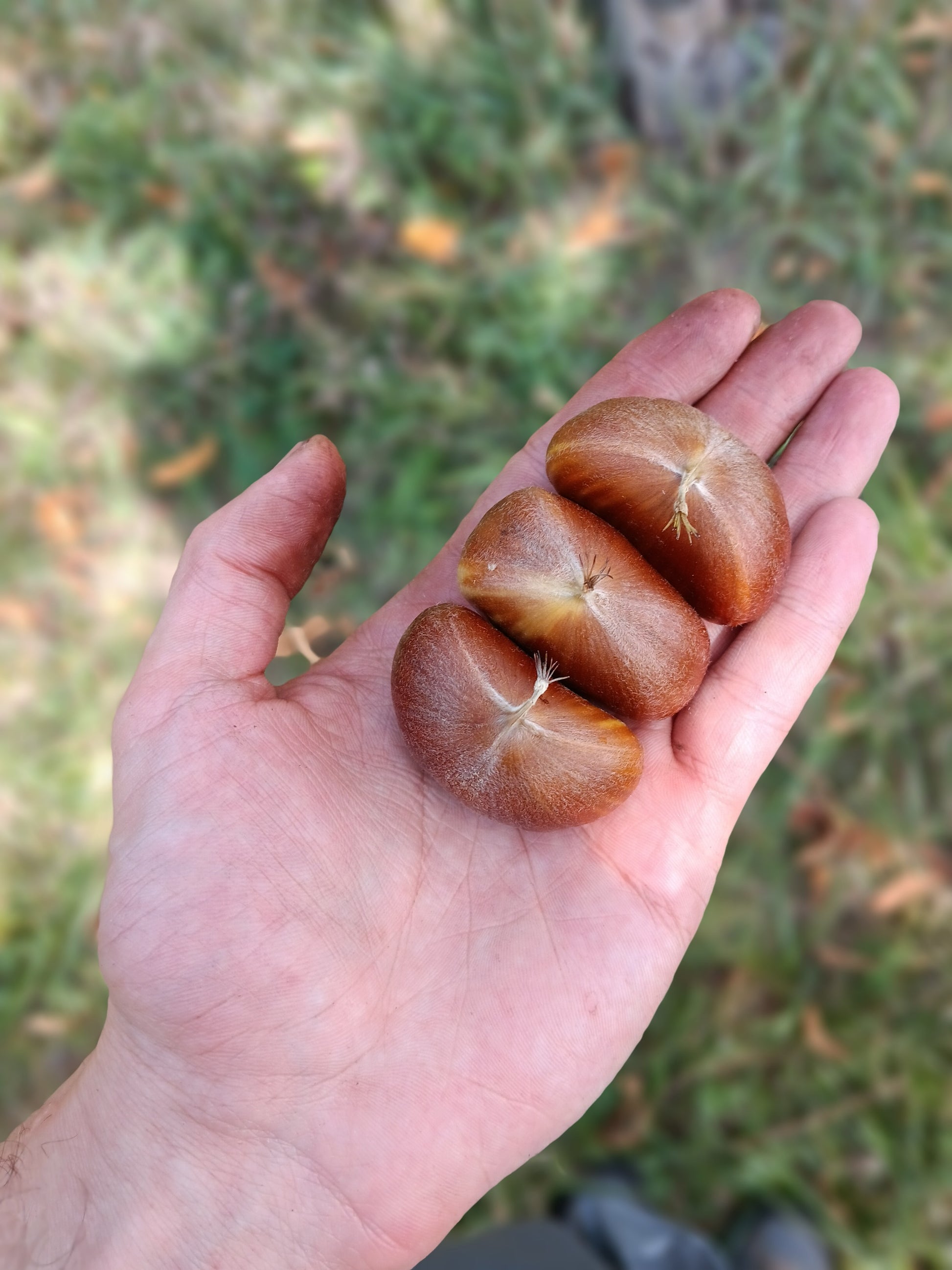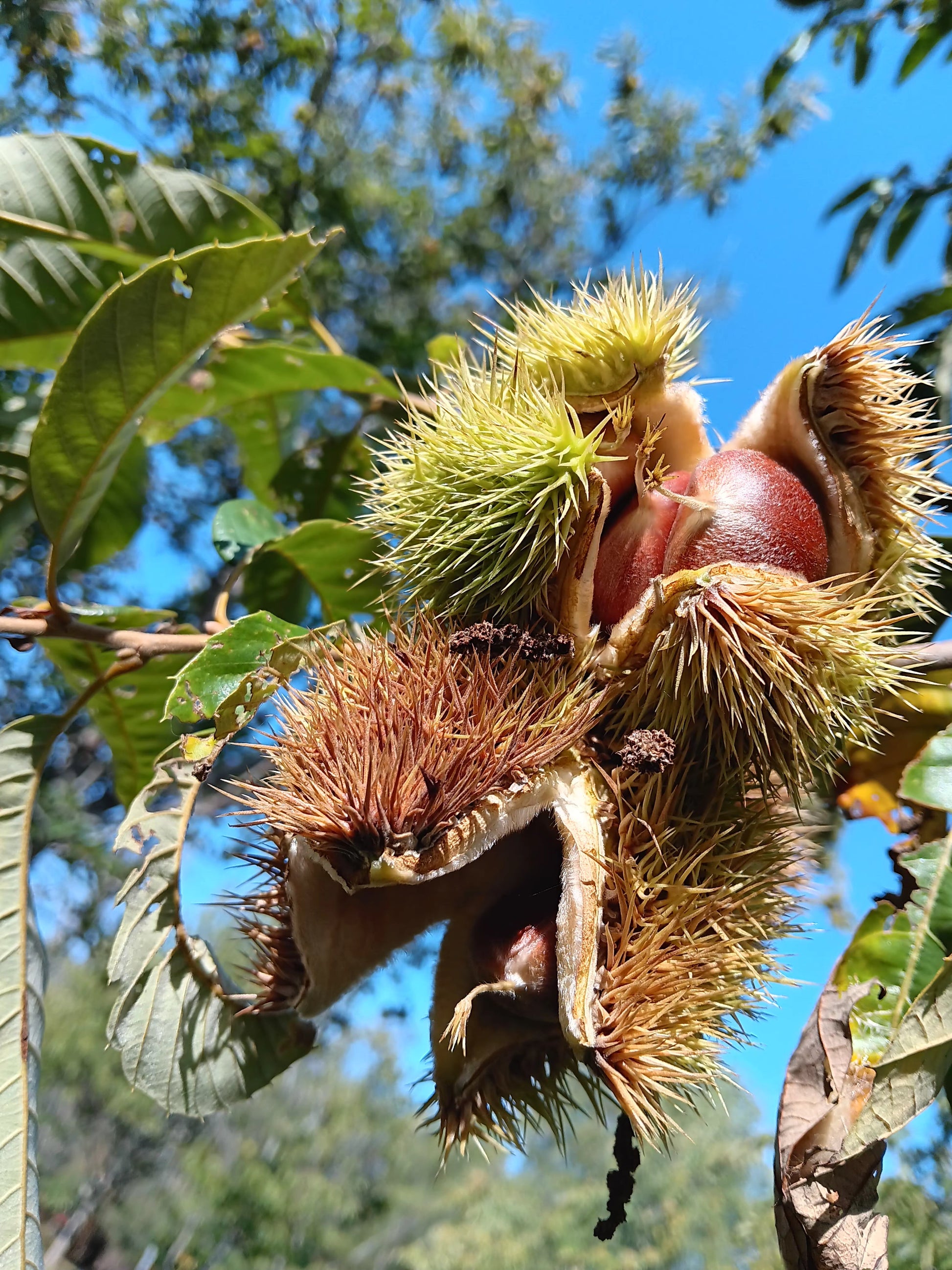La Réfriche Nursery
Hybrid chestnut (Castanea X spp.)- Zone 5b
Hybrid chestnut (Castanea X spp.)- Zone 5b
Couldn't load pickup availability
The Castanea botanical family is found in many parts of the world. In France, some people call them 'Marrons', while in North America, it's possible to grow all six species in this family. Our hybrid chestnut selections are the most interesting candidates for planting in minimum zones 5a to 6a, according to the opinions of various American experts.
530 G’ville Road Complex hybrid from John W. Hershey. One of his most interesting trees. It produces heavy crops of sweet chinese type nut of medium size. The only tree that seems to have an issue with my culture. So far 4 out of 25 died with no sign of chestnut blight. It might be phytoptora root rot, as the season was very wet. It could be a localised pH issue as well. I am keeping an eye on them. Zone 6a and over.
Layeroka Hybrid of John U. Gellatly. A vigorous parent that offers the hardiest offspring. Male catkins are sterile. Nut shells can crack with a heavy rain near the ripening. Interesting tree for breeding as it is cold hardy and needs less GDD than the average to ripen. It should be crossed with chestnut blight resistant trees as Layeroka from Grimo nut nursery died in a high blight pressure environment. Zone 5a and over.
Mahogany x Nanking A C.mollissima x C. mollissima cross selection. The best cross out of 200 made with the same parentage. Ideal mollissima rootstock as it is vigorous and a heavy producer. Zone 6a and over.
Seedling of ACE The mother tree of this seedling had American, Chinese and European genetics, an easy peeling Chinese type nut with good flavor and hardy producer in USDA zone 5. The seedling of Ace’s pollen is sterile. Two seedlings of a male sterile mother tree has lower chance to pollinise eachother. The best practice is to plant a seedling from a male fertile mother tree nearby. Zone 5b and over.
Eaton mollissima x (crenata x dentata). A great tree from Ct Ag Experimental Station. Large delicious nuts 30/lb. Zone 6a and over.
American R2T5 C. dentata hybrid. Survivor from the CAES plantings. Trees not resistant to chestnut blight died. Zone 5a and over.
RR Vigorous Sleeping Giant Seedling of Sleeping Giant C. mollissima x (crenata x dentata) Consistent producer of medium large handsome nuts, about 40 per lb. Reasonably hardy in mid Vermont. Large tree. Connecticut Agricultural Experiment Station selection. Zone 5b and over.
Sadie Hunter Rootstock sprout from a failed graft of Sleeping Giant. A likely offspring of Sleeping Giant. So far quite hardy in mid Vermont. Connecticut Agricultural Experiment Station selection. Zone 5a and over.
RR Sweet Green Liu Seedling of Liu from the Finger Lakes area. Chinese tree producing sweet nuts like Qing. About the grandmother tree : ‘’After storing dozens of cultivar nuts for seed we discovered one outstanding cultivar that had near zero blossom end rot and near zero storage rots for 2 years running: Namely ‘Liu’ ‘’ - Greg Miller Zone 5b and over.
Qing Is a cultivar of unknown origin found in Hickory (Kentucky) and named by Mike Nave. It is a very hardy (relative hardiness of -30C branches and -29C flower buds tested in a lab. True hardiness in a field is more as the organs are related to the rest of the tree. Hardiest scores from a pool of Luvall’s monster, ACE, Peach, etc.) Chinese type hybrid that is probably hybridized with c. pumila. Very sweet nuts of good size (20-25g/nut) that are ready to eat raw as they fall off the tree. Mid season producer that resists well to the late frosts. Zone 5a and over.
R.R. Qing #1, #2 and #4 Seedlings of Qing still unnamed, but productive in the Finger Lakes, NY. Grandmother being Qing 25% genetics are from Qing. Mother tree likely have cross pollenized with a chinese tree also productive in NY. Zone 5b and over.
Biotope
Biotope
Biotopes suitable for growing hybrid chestnuts may vary depending on the seed source. In addition to the species used for hybridization, the different soils and climates where these crossbreeds were made will influence the environments conducive to their development.
Soil types
Chestnut trees of all species do not like soil where water accumulates. Transplanting into soil with a water table below 60 cm will result in the death of the plant by root asphyxia after 2 months. Being a mountain species, chestnut trees prefer aerated, acidic soil with a pH between 5 and 6. Chestnut can be grown in very acidic soils with a pH of 4.5, or even more basic soils with a pH of 6.5. The species best suited to alkaline soil types would probably be the European chestnut (Castanea Sativa), but then again, it should be hybrid chestnut seedlings (for hardiness and disease resistance) grown in alkaline soils.
Hardiness
Zone 4: Your best choices are pure American chestnuts. It is possible, but risky, to experiment with hybrid Castanea dentata x Castanea mollissima chestnut trees.
Zone 5: Your best choices are hybrid chestnut trees with Chinese and American genetics (Castanea dentata x Castanea mollissima) from sources whose mother plants are known to be hardy. Experimenting with hybrids from unknown sources is possible but risky.
Zone 6: Your best choices are pure Chinese chestnut trees or hybrid chestnut trees selected for the hardiness of the mother plants and the quality of their nuts. Generally speaking, the presence of American chestnut (Castanea dentata) increases the hardiness of crossbreeds. This is not a rule without exceptions. The most important thing is the seed source. Thus, a hybrid chestnut grown in Quebec will be better adapted to the Quebec climate than an American chestnut from Kentucky.
Disease resistance
The main disease affecting chestnut trees is Eastern chestnut blight (Cryphonectria parasitica). Pure American and European chestnut trees are not resistant to it, and typically die within three years of infection.
In addition, a second disease, phytophtora cinnamomi, a fungus-linked infection found in moist soils, affects European and American chestnut trees in the same way. Chinese and Japanese chestnut trees are resistant to this disease, hence the importance of hybridizing different chestnut species and planting hybrids.
For your information, a rainy season like 2023 can kill seedlings that are not resistant to phytophtora cinnamomi. We did not observe any problems in the majority of our seed sources, but 80% of the 530 G'ville roads died.
Wood
Wood
Chestnut wood may be of interest to cabinet-makers, but chestnut cannot currently compete with local nut tree species in terms of barrel quality.
Research is underway into the selection of chestnut species with wood that is vigorous and has a high apical demand, implying vigorous genetics in all species.
Size and shape
Size and shape
Chinese chestnut trees that grow in full sun without competition generally have little apical dominance.
Some hybrids, such as Szego, R2t5 and Layeroka, have better apical dominance.
As the populations are highly diversified, the vigor, habit and height of each of our seedlings will vary greatly.
We recommend planting the trees at 7m centers.
Pollination
Pollination
For effective pollination, we recommend planting at least three chestnut trees, with a maximum of one male-sterile chestnut.
Source
Source
Our selections are outstanding individuals worthy of propagation by seed from commercial orchards or university research centers.
Share
